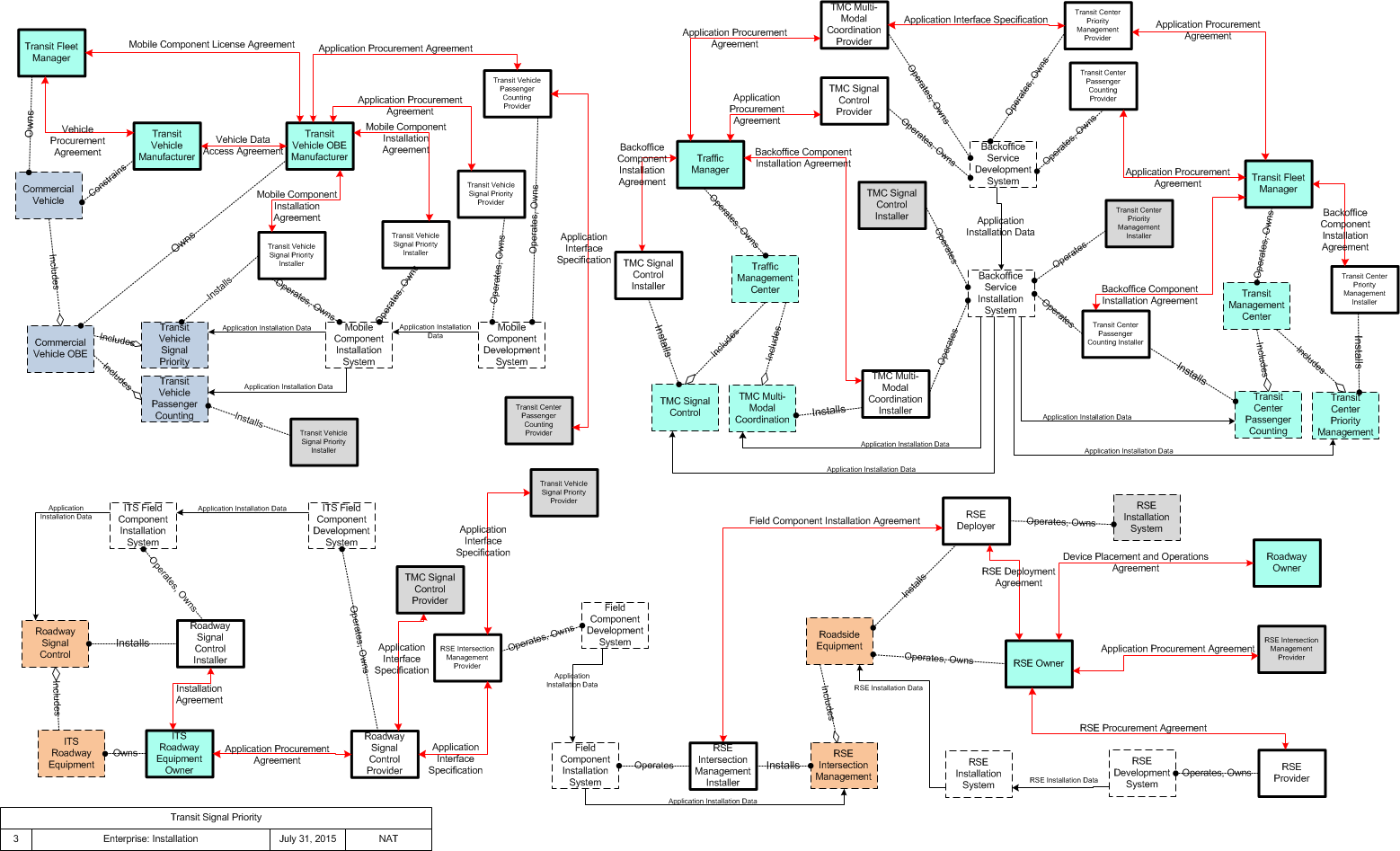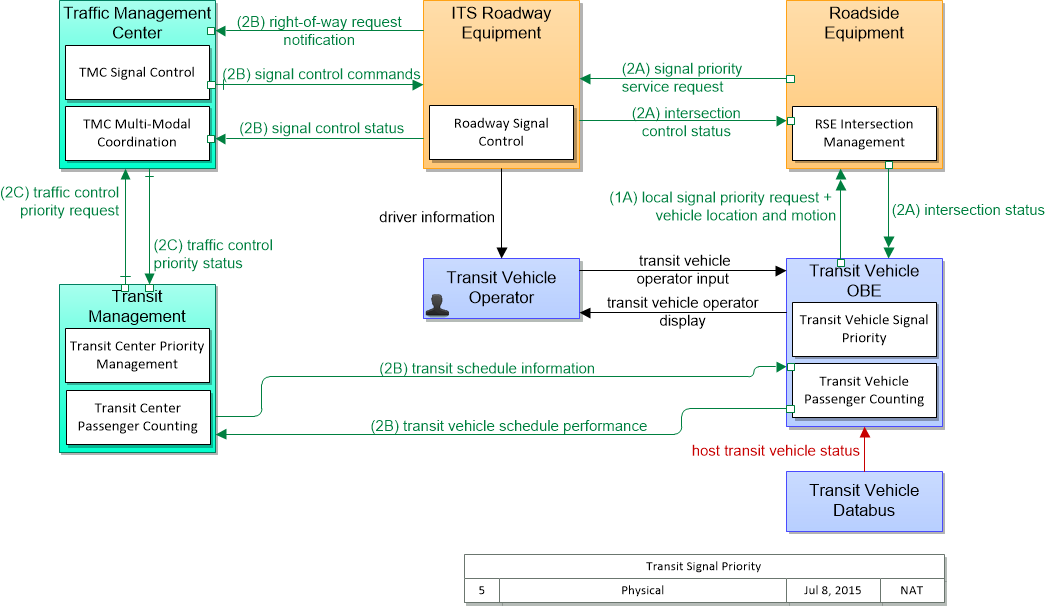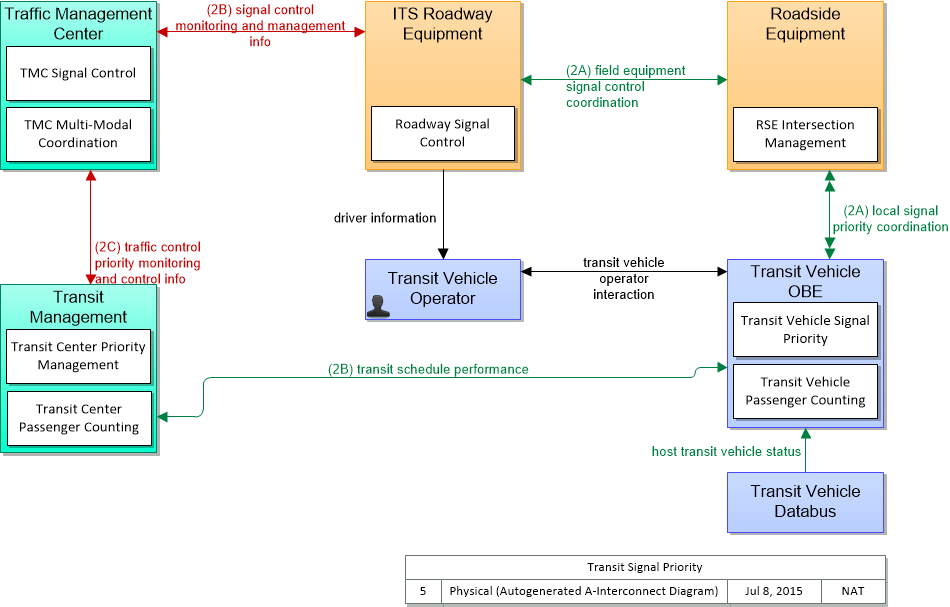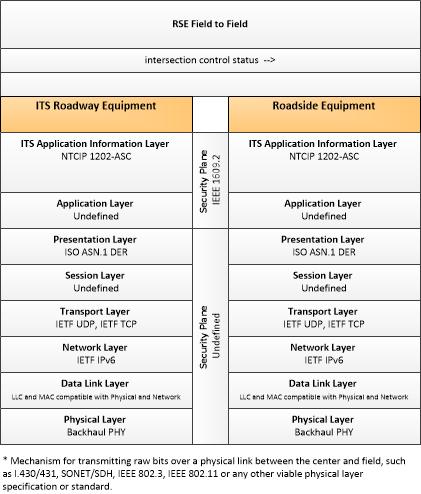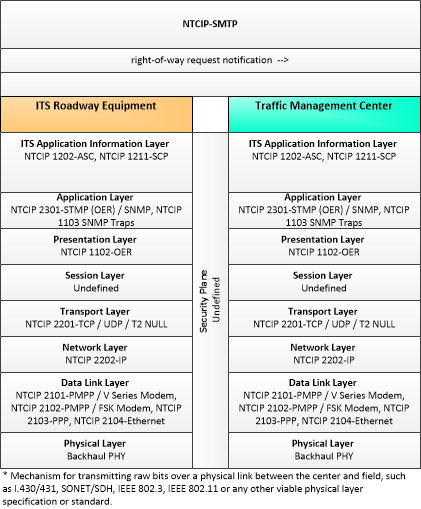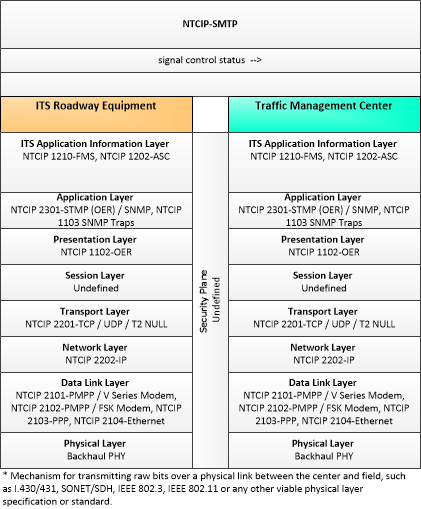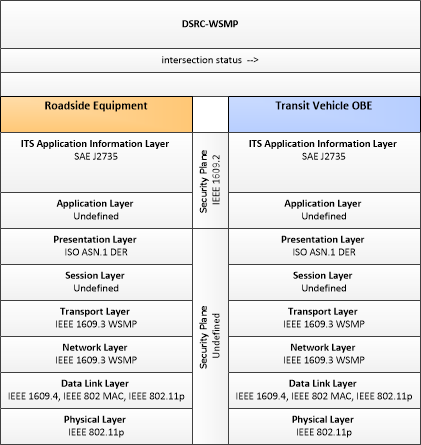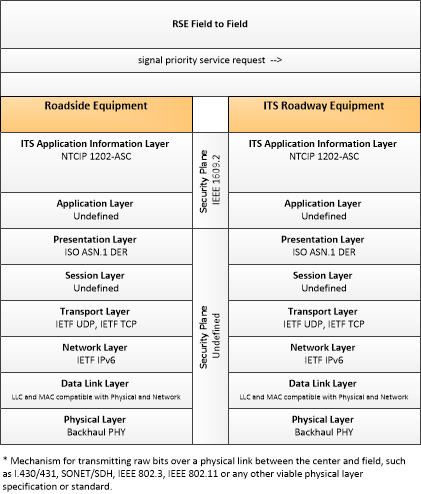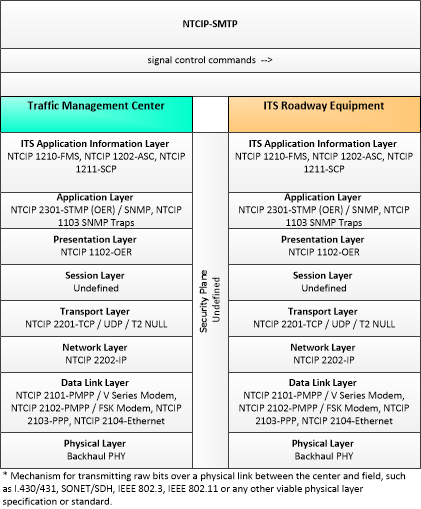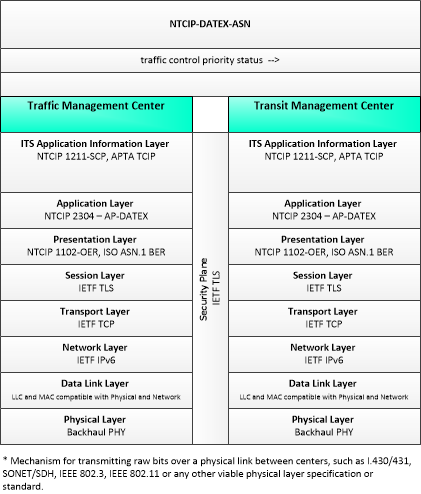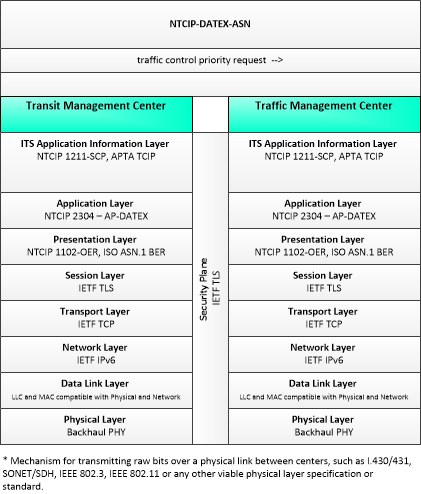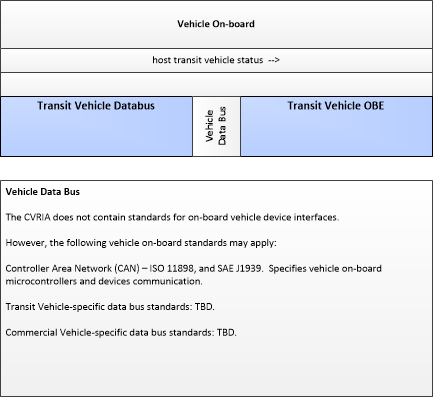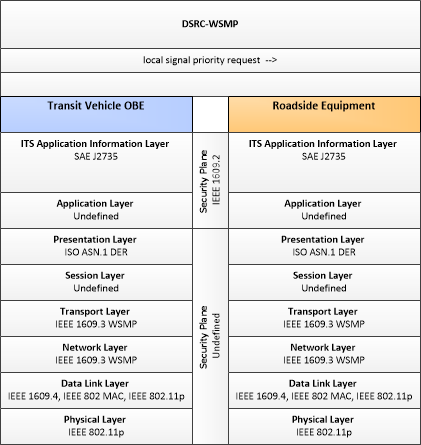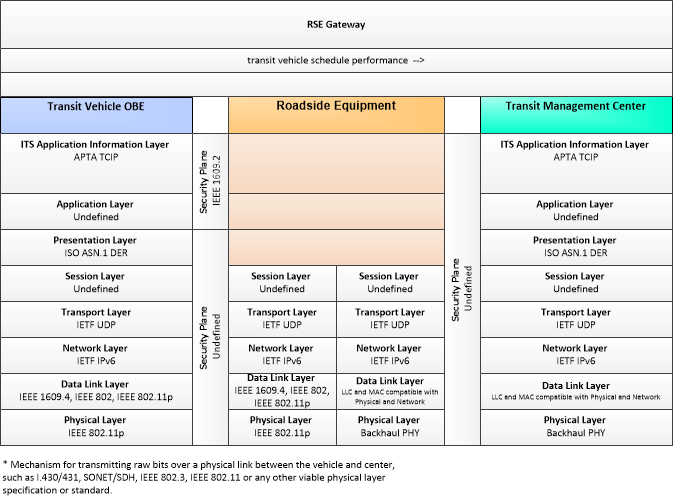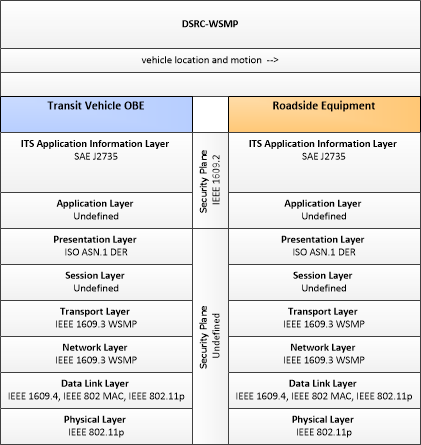Type: Mobility
Groups:- Traffic Signals
Transit Signal Priority
The Transit Signal Priority application uses transit vehicle to infrastructure communications to allow a transit vehicle to request an priority at one or a series of intersection. The application includes feedback to the transit driver indicating whether the signal priority has been granted or not. This application can contribute to improved operating performance of the transit vehicles by reducing the time spent stopped at a red light.
Enterprise
This is one way this application may be realized, but not the only way. There are other ways to build a given application and accomplish a stated objective.
The enterprise diagram can be viewed in SVG or PNG format and the current format is SVG. SVG Diagrams: Installation Operations Maintenance Certification
PNG Diagrams: Installation Operations Maintenance Certification

Business Interaction Matrix:
| Transit Signal Priority Operations Stage | |||||||||||
|---|---|---|---|---|---|---|---|---|---|---|---|
| Roadway Owner | RSE Owner | RSE Operator | ITS Roadway Equipment Owner | ITS Roadway Operator | Transit Vehicle Operator | Traffic Manager | RSE Intersection Management Provider | Transit Vehicle Signal Priority Provider | Transit Vehicle Passenger Counting Provider | Transit Fleet Manager | |
| Roadway Owner | Service Delivery Agreement | ||||||||||
| RSE Owner | Service Delivery Agreement | Operations Agreement | Information Exchange and Action Agreement | Application Usage Agreement | |||||||
| RSE Operator | Operations Agreement | ||||||||||
| ITS Roadway Equipment Owner | Information Exchange and Action Agreement | Operations Agreement | Information Exchange and Action Agreement | ||||||||
| ITS Roadway Operator | Operations Agreement | Expectation of Information Provision | |||||||||
| Transit Vehicle Operator | Expectation of Information Provision | Vehicle Usage Agreement | |||||||||
| Traffic Manager | Information Exchange and Action Agreement | Information Exchange Agreement | |||||||||
| RSE Intersection Management Provider | Application Usage Agreement | ||||||||||
| Transit Vehicle Signal Priority Provider | Application Usage Agreement | ||||||||||
| Transit Vehicle Passenger Counting Provider | Application Usage Agreement | ||||||||||
| Transit Fleet Manager | Vehicle Usage Agreement | Information Exchange Agreement | Application Usage Agreement | Application Usage Agreement | Expectation of Data Provision | ||||||
Includes Enterprise Objects:
| Enterprise Object | Description |
|---|---|
| Application Certification Entity | The body that determines whether an application may be deployed and operated in the Connected Vehicle Environment. This entity's composition, the requirements it applies and the procedures it uses to verify those requirements may vary with application type. For example, applications with human safety component (crash avoidance, movement assistance etc.) may have stringent requirements and extensive testing in a variety of conditions, while applications that provide strictly mobility functionality may have far less testing requirements; possibly as little as just making sure the application doesn't interfere with any other applications. |
| Device Certification Entity | The body that determines whether a device may be deployed and operated in the Connected Vehicle Environment. This entity's composition, the requirements it applies and the procedures it uses to verify those requirements may vary with device type. |
| Federal Regulatory | Federal regulatory bodies that have legal authority to control and/or provide input to policies regulating transportation infrastructure and operations. This includes entities such as the Federal Communications Commission and US Department of Transportation. |
| ITS Certification Entity | The body that determines whether an ITS device or application may be deployed and operated in the transportation environment. This entity's composition, the requirements it applies and the procedures it uses to verify those requirements may vary with device and application type. Typically not a formal body, assigned on a project-by-project basis depending on the type of infrastructure involved. Since ITS projects are locally-focused (typically state or smaller), the entities that are part of this body are typically those with operational jurisdiction where the ITS is installed (e.g., state or local DOTs, state or local maintenance managers etc.) |
| ITS Roadway Equipment Owner | The entity that owns the Roadway ITS equipment. |
| ITS Roadway Operator | The entity that operates the Roadway ITS equipment. |
| Roadway Owner | The owner of the roadway proximate to which roadside equipment will be/is installed. |
| Roadway Signal Control Installer | Application Component Installers are specified more by role than by function. Installers are responsible for the installation of the application component, which may require a support system, and may entail agreements and relationships between end users and application providers. |
| Roadway Signal Control Maintainer | Application Component Maintainers are specified more by role than by function. Maintainers are responsible for the maintenance (configuration changes, patches and updates, hardware repairs) of the application component, which may require a support system, and may entail agreements and relationships between end users and application providers. |
| Roadway Signal Control Provider | Application Component Providers are specified more by role than by function. Providers are responsible for the development of the application component, including initial creation, enhancement and bug fixes. Delivery of the application to the end user may require relationships with other entities (installers, maintainers) if the provider chooses not to fulfill those roles. |
| RSE Deployer | The entity responsible for the deployment, operations and maintenance of roadside equipment. |
| RSE Intersection Management Installer | Application Component Installers are specified more by role than by function. Installers are responsible for the installation of the application component, which may require a support system, and may entail agreements and relationships between end users and application providers. |
| RSE Intersection Management Maintainer | Application Component Maintainers are specified more by role than by function. Maintainers are responsible for the maintenance (configuration changes, patches and updates, hardware repairs) of the application component, which may require a support system, and may entail agreements and relationships between end users and application providers. |
| RSE Intersection Management Provider | Application Component Providers are specified more by role than by function. Providers are responsible for the development of the application component, including initial creation, enhancement and bug fixes. Delivery of the application to the end user may require relationships with other entities (installers, maintainers) if the provider chooses not to fulfill those roles. |
| RSE Operator | The entity that operates roadside equipment in the transportation environment. |
| RSE Owner | The owner of roadside equipment. |
| RSE Provider | The "RSE Provider" is the entity that develops and (presumably) sells roadside equipment to other entities for deployment and research. |
| State Regulatory | State regulatory bodies that have legal authority to control and/or provide input to policies regulating vehicles, transportation infrastructure and operations. This includes entities like Departments of Motor Vehicles, property tax authorities and tolling agencies. |
| TMC Multi-Modal Coordination Installer | Application Component Installers are specified more by role than by function. Installers are responsible for the installation of the application component, which may require a support system, and may entail agreements and relationships between end users and application providers. |
| TMC Multi-Modal Coordination Maintainer | Application Component Maintainers are specified more by role than by function. Maintainers are responsible for the maintenance (configuration changes, patches and updates, hardware repairs) of the application component, which may require a support system, and may entail agreements and relationships between end users and application providers. |
| TMC Multi-Modal Coordination Provider | Application Component Providers are specified more by role than by function. Providers are responsible for the development of the application component, including initial creation, enhancement and bug fixes. Delivery of the application to the end user may require relationships with other entities (installers, maintainers) if the provider chooses not to fulfill those roles. |
| TMC Signal Control Installer | Application Component Installers are specified more by role than by function. Installers are responsible for the installation of the application component, which may require a support system, and may entail agreements and relationships between end users and application providers. |
| TMC Signal Control Maintainer | Application Component Maintainers are specified more by role than by function. Maintainers are responsible for the maintenance (configuration changes, patches and updates, hardware repairs) of the application component, which may require a support system, and may entail agreements and relationships between end users and application providers. |
| TMC Signal Control Provider | Application Component Providers are specified more by role than by function. Providers are responsible for the development of the application component, including initial creation, enhancement and bug fixes. Delivery of the application to the end user may require relationships with other entities (installers, maintainers) if the provider chooses not to fulfill those roles. |
| Traffic Manager | The entity responsible for the management of traffic, both freeway and arterial. |
| Transit Center Passenger Counting Installer | Application Component Installers are specified more by role than by function. Installers are responsible for the installation of the application component, which may require a support system, and may entail agreements and relationships between end users and application providers. |
| Transit Center Passenger Counting Maintainer | Application Component Maintainers are specified more by role than by function. Maintainers are responsible for the maintenance (configuration changes, patches and updates, hardware repairs) of the application component, which may require a support system, and may entail agreements and relationships between end users and application providers. |
| Transit Center Passenger Counting Provider | Application Component Providers are specified more by role than by function. Providers are responsible for the development of the application component, including initial creation, enhancement and bug fixes. Delivery of the application to the end user may require relationships with other entities (installers, maintainers) if the provider chooses not to fulfill those roles. |
| Transit Center Priority Management Installer | Application Component Installers are specified more by role than by function. Installers are responsible for the installation of the application component, which may require a support system, and may entail agreements and relationships between end users and application providers. |
| Transit Center Priority Management Maintainer | Application Component Maintainers are specified more by role than by function. Maintainers are responsible for the maintenance (configuration changes, patches and updates, hardware repairs) of the application component, which may require a support system, and may entail agreements and relationships between end users and application providers. |
| Transit Center Priority Management Provider | Application Component Providers are specified more by role than by function. Providers are responsible for the development of the application component, including initial creation, enhancement and bug fixes. Delivery of the application to the end user may require relationships with other entities (installers, maintainers) if the provider chooses not to fulfill those roles. |
| Transit Fleet Manager | The agency or organization that operates transit vehicles. This includes administration, routing, driver instruction, maintenance and any other responsibilities associated with the operations and maintenance of a transit system. |
| Transit Vehicle Manufacturer | The entity which builds transit vehicles. This entity is complementary to the Vehicle Manufacturer entity in that it represents those aspects of vehicle manufacture which are unique to transit vehicles. |
| Transit Vehicle OBE Manufacturer | The Transit Vehicle OBE Manufacturer is the provider of the transit vehicle on-board equipment. This entity may design and build the OBE, or may integrate other components to form the OBE, or may use some combination of approaches to provide the on-board equipment. Since the OBE could be aftermarket, retrofit, built-in or nomadic, this entity is the one that builds whatever that-is. In some cases it may be a smart phone manufacturer, or in others a top tier parts supplier, or any other entity in the production chain, depending on the device and commercial vehicle in question. |
| Transit Vehicle Operator | The 'Transit Vehicle Operator' represents the person that receives and provides additional information that is specific to operating the ITS functions in all types of transit vehicles. The information received by the operator would include status of on-board systems. Additional information received depends upon the type of transit vehicle. In the case of fixed route transit vehicles, the Transit Vehicle Operator would receive operator instructions that might include actions to take to correct schedule deviations. In the case of flexible fixed routes and demand response routes the information would also include dynamic routing or passenger pickup information. |
| Transit Vehicle Passenger Counting Maintainer | Application Component Maintainers are specified more by role than by function. Maintainers are responsible for the maintenance (configuration changes, patches and updates, hardware repairs) of the application component, which may require a support system, and may entail agreements and relationships between end users and application providers. |
| Transit Vehicle Passenger Counting Provider | Application Component Providers are specified more by role than by function. Providers are responsible for the development of the application component, including initial creation, enhancement and bug fixes. Delivery of the application to the end user may require relationships with other entities (installers, maintainers) if the provider chooses not to fulfill those roles. |
| Transit Vehicle Signal Priority Installer | Application Component Installers are specified more by role than by function. Installers are responsible for the installation of the application component, which may require a support system, and may entail agreements and relationships between end users and application providers. |
| Transit Vehicle Signal Priority Maintainer | Application Component Maintainers are specified more by role than by function. Maintainers are responsible for the maintenance (configuration changes, patches and updates, hardware repairs) of the application component, which may require a support system, and may entail agreements and relationships between end users and application providers. |
| Transit Vehicle Signal Priority Provider | Application Component Providers are specified more by role than by function. Providers are responsible for the development of the application component, including initial creation, enhancement and bug fixes. Delivery of the application to the end user may require relationships with other entities (installers, maintainers) if the provider chooses not to fulfill those roles. |
| Vehicle OBE Manufacturer | The entity that builds, assembles, verifies and validates the Vehicle OBE. This can be an OEM-equipped OBE, retrofit or aftermarket equipment. |
Includes Resources:
| Resource | Description |
|---|---|
| Application Component Certification Requirements | The requirements that define the functionality, performance and operational environment of an application component. Certification Requirements must be met in order for an application to be installed in the CVE. |
| Backoffice Service Development System | The systems used to develop backoffice (center) hardware and software components of applications. |
| Backoffice Service Installation System | The systems used to install and configure backoffice (center) hardware and software components. |
| Backoffice Service Maintenance System | The systems used to maintain and upgrade backoffice (center) hardware and software components. |
| Commercial Vehicle | The commercial vehicle includes the sensory, processing, storage, and communications functions necessary to support safe and efficient commercial vehicle operations. It includes two-way communications between the commercial vehicle drivers, their fleet managers, attached freight equipment, and roadside officials, and provides HAZMAT response teams with timely and accurate cargo contents information after a vehicle incident. It can collect and process vehicle, cargo information from the attached freight equipment, and driver safety data and status and alert the driver whenever there is a potential safety or security problem. Basic identification, security and safety status data are supplied to inspection facilities at mainline speeds. In addition, it can automatically collect and record mileage, fuel usage, and border crossings. |
| Commercial Vehicle OBE | The Commercial Vehicle On-Board Equipment (OBE) resides in a commercial vehicle and provides the sensory, processing, storage, and communications functions necessary to support safe and efficient commercial vehicle operations. It provides two-way communications between the commercial vehicle drivers, their fleet managers, attached freight equipment, and roadside officials. In CVRIA, a separate 'Vehicle OBE' physical object supports the general V2V and V2I safety applications and other applications that apply to all vehicles, including commercial vehicles. The Commercial Vehicle OBE supplements these general capabilities with capabilities that are specific to commercial vehicles. |
| Device Certification Requirements | The requirements that define the functionality, performance and operational environment of a connected vehicle device. Certification Requirements must be met in order for the device to be granted the credentials necessary to operate in the Connected Vehicle Environment. |
| Field Component Development System | The system used in a backoffice environment to develop and test the field component of the application. |
| Field Component Installation System | The system used to install a field component of a connected vehicle application. |
| Field Component Maintenance System | The system used to install and configure changes and updates to the field component of the application. This system is capable of acquiring and reporting diagnostic information about the application's configuration and performance. |
| ITS Certification Requirements | The requirements that define the functionality, performance and operational environment of an ITS device or ITS application. Applicability varies with jurisdictions, but typically devices and applications must meet pre-defined acceptance criteria prior to usage in the transportation environment. |
| ITS Field Component Development System | The system used in a backoffice environment to develop and test the ITS field component of the application. |
| ITS Field Component Installation System | The system used to install a field component of a connected vehicle application. |
| ITS Field Component Maintenance System | The system used to install and configure changes and updates to the ITS field component of the application. This system is capable of acquiring and reporting diagnostic information about the application's configuration and performance. |
| ITS Roadway Equipment | 'ITS Roadway Equipment' represents the ITS equipment that is distributed on and along the roadway that monitors and controls traffic and monitors and manages the roadway itself. In CVRIA, this physical object represents all of the other ITS field equipment that interfaces with and supports the Connected Vehicle Roadside Equipment (RSE). This physical object includes traffic detectors, environmental sensors, traffic signals, highway advisory radios, dynamic message signs, CCTV cameras and video image processing systems, grade crossing warning systems, and ramp metering systems. Lane management systems and barrier systems that control access to transportation infrastructure such as roadways, bridges and tunnels are also included. This object also provides environmental monitoring including sensors that measure road conditions, surface weather, and vehicle emissions. Work zone systems including work zone surveillance, traffic control, driver warning, and work crew safety systems are also included. |
| Mobile Component Development System | The system used in a backoffice environment to develop and test the mobile component of the application. |
| Mobile Component Installation System | The system that interacts with the Vehicle OBE other mobile device and installs the mobile component of the application. |
| Mobile Component Maintenance System | The system used to configure changes and updates to the mobile component of the application. This system is capable of acquiring and reporting diagnostic information about the application's configuration and performance. |
| Roadside Equipment | 'Roadside Equipment' (RSE) represents the Connected Vehicle roadside devices that are used to send messages to, and receive messages from, nearby vehicles using Dedicated Short Range Communications (DSRC) or other alternative wireless communications technologies. Communications with adjacent field equipment and back office centers that monitor and control the RSE are also supported. This device operates from a fixed position and may be permanently deployed or a portable device that is located temporarily in the vicinity of a traffic incident, road construction, or a special event. It includes a processor, data storage, and communications capabilities that support secure communications with passing vehicles, other field equipment, and centers. |
| Roadway Signal Control | "Roadway Signal Control" includes the field elements that monitor and control signalized intersections. It includes the traffic signal controllers, detectors, conflict monitors, signal heads, and other ancillary equipment that supports traffic signal control. It also includes field masters, and equipment that supports communications with a central monitoring and/or control system, as applicable. The communications link supports upload and download of signal timings and other parameters and reporting of current intersection status. It represents the field equipment used in all levels of traffic signal control from basic actuated systems that operate on fixed timing plans through adaptive systems. It also supports all signalized intersection configurations, including those that accommodate pedestrians. In advanced, future implementations, environmental data may be monitored and used to support dilemma zone processing and other aspects of signal control that are sensitive to local environmental conditions. |
| RSE Development System | The system used in a backoffice environment to develop and test the roadside equipment. |
| RSE Installation System | The system used to install and configure the roadside equipment. |
| RSE Intersection Management | "RSE Intersection Management" uses short range communications to support connected vehicle applications that manage signalized intersections. It communicates with approaching vehicles and ITS infrastructure (e.g., the traffic signal controller) to enhance traffic signal operations. Coordination with the ITS infrastructure also supports conflict monitoring to ensure the RSE output and traffic signal control output are consistent and degrade in a fail safe manner. |
| RSE Maintenance System | The system used to configure changes and updates to the roadside equipment. This system is capable of acquiring and reporting diagnostic information about the RSE's configuration and performance. |
| TMC Multi-Modal Coordination | "TMC Multi-Modal Coordination" supports center-to-center coordination between the Traffic Management and Transit Management Centers. It monitors transit operations and provides traffic signal priority for transit vehicles on request from the Transit Management Center. |
| TMC Signal Control | "TMC Signal Control" provides the capability for traffic managers to monitor and manage the traffic flow at signalized intersections. This capability includes analyzing and reducing the collected data from traffic surveillance equipment and developing and implementing control plans for signalized intersections. Control plans may be developed and implemented that coordinate signals at many intersections under the domain of a single traffic management center and are responsive to traffic conditions and adapt to support incidents, preemption and priority requests, pedestrian crossing calls, etc. |
| Traffic Management Center | The 'Traffic Management Center' monitors and controls traffic and the road network. It represents centers that manage a broad range of transportation facilities including freeway systems, rural and suburban highway systems, and urban and suburban traffic control systems. It communicates with ITS Roadway Equipment and Connected Vehicle Roadside Equipment (RSE) to monitor and manage traffic flow and monitor the condition of the roadway, surrounding environmental conditions, and field equipment status. It manages traffic and transportation resources to support allied agencies in responding to, and recovering from, incidents ranging from minor traffic incidents through major disasters. |
| Transit Center Passenger Counting | "Transit Center Passenger Counting" receives and processes transit vehicle loading data using two-way communications from equipped transit vehicles. |
| Transit Center Priority Management | "Transit Center Priority Management" monitors transit schedule performance and generates requests for transit priority on routes and at certain intersections. It may coordinate with the Traffic Management Center to provide transit priority along the selected route, including allocation of dynamic lanes and granting signal priority. It also coordinates with the Transit Vehicle OBE to monitor and manage local transit signal priority requests at individual intersections. |
| Transit Management Center | The 'Transit Management Center' manages transit vehicle fleets and coordinates with other modes and transportation services. It provides operations, maintenance, customer information, planning and management functions for the transit property. It spans distinct central dispatch and garage management systems and supports the spectrum of fixed route, flexible route, paratransit services, transit rail, and bus rapid transit (BRT) service. The physical object's interfaces allow for communication between transit departments and with other operating entities such as emergency response services and traffic management systems. |
| Transit Vehicle | The vehicle that provides the sensory, processing, storage, and communications functions necessary to support safe and efficient movement of passengers. This includes buses, paratransit vehicles, light rail vehicles, other vehicles designed to carry passengers, and supervisory vehicles. |
| Transit Vehicle OBE | The Transit Vehicle On-Board equipment (OBE) resides in a transit vehicle and provides the sensory, processing, storage, and communications functions necessary to support safe and efficient movement of passengers. The types of transit vehicles containing this physical object include buses, paratransit vehicles, light rail vehicles, other vehicles designed to carry passengers, and supervisory vehicles. It collects ridership levels and supports electronic fare collection. It supports a traffic signal prioritization function that communicates with the roadside physical object to improve on-schedule performance. Automated vehicle location enhances the information available to the transit operator enabling more efficient operations. On-board sensors support transit vehicle maintenance. The physical object supports on-board security and safety monitoring. This monitoring includes transit user or vehicle operator activated alarms (silent or audible), as well as surveillance and sensor equipment. The surveillance equipment includes video (e.g. CCTV cameras), audio systems and/or event recorder systems. It also furnishes travelers with real-time travel information, continuously updated schedules, transfer options, routes, and fares. In CVRIA, a separate 'Vehicle OBE' physical object supports the general V2V and V2I safety applications and other applications that apply to all vehicles, including transit vehicles. The Transit Vehicle OBE supplements these general capabilities with capabilities that are specific to transit vehicles. |
| Transit Vehicle Passenger Counting | "Transit Vehicle Passenger Counting" collects transit vehicle loading data and makes it available to the center. |
| Transit Vehicle Signal Priority | "Transit Vehicle Signal Priority" provides the capability for transit vehicles to determine eligibility for priority and request signal priority at signalized intersections, ramps, and interchanges through short range communication with traffic control equipment at the roadside. |
Includes Roles:
| Role | Description |
|---|---|
| Certifies | An Enterprise verifies that a target Resource meets relevant performance, functional, environmental and quality requirements. |
| Constrains | A Resource or Enterprise applies requirements, constraints and associated tests to another Resource. |
| Installs | An Enterprise performs the initial delivery, integration and configuration of the target Resource. |
| Maintains | An Enterprise administers the hardware and software that comprise the target Resource. |
| Member | An Enterprise is part of another larger, target Enterprise. |
| Operates | An Enterprise controls the functionality and state of the target Resource. An Enterprise that Operates a resource is considered Responsible. |
| Owns | An Enterprise has financial ownership and control over the Resource. An Enterprise that Owns a resource is considered Accountable. |
Includes Coordination:
| Coordination | Type | Description |
|---|---|---|
| Application Installation Data | Information Sharing | Data needed to install the application, including the application executable code and any configuration data. Unidirectional flow. |
| Application Interface Specification | Agreement | The definition of an interface between two application components that operate on two distinct pieces of hardware. The Application Interface Specification is specific to the application in question. |
| Application Maintenance Data | Information Sharing | Data used to facilitate the upgrade, patching and general health maintenance of an application component. |
| Application Performance Data | Information Sharing | Data used to characterize application performance, including such measures as availability, known errors and known uses. |
| Application Procurement Agreement | Agreement | An agreement whereupon one entity provides a copy of an application component to another entity. This component is capable of being installed and functioning, according to its requirements that passed through the application's certification process. |
| Application Usage Agreement | Agreement | An agreement in which one entity that controls an application component's use gives the other entity the necessary tools and permission to operate that application or application component. |
| Backoffice Component Installation Agreement | Agreement | An agreement that grants one party permission to install a backoffice application component on a center-based device controlled by the other party. |
| Device Placement and Operations Agreement | Agreement | An agreement that enables the controller of a physical device to install it (so as to make it operational) at a fixed location controlled by another entity. |
| Expectation of Data Provision | Expectation | An expectation where one party believes another party will provide data on a regular and recurring basis, and that that data will be useful to the receiver in the context of the receiver's application. This thus includes some expectation of data fields, timeliness, quality, precision and similar qualities of data. |
| Expectation of Information Provision | Expectation | An expectation where one party believes another party will provide it information whenever such information is likely relevant to the recipient. |
| Field Component Installation Agreement | Agreement | An agreement that grants one party permission to install a field application component on a roadside device controlled by the other party. |
| Includes | Includes | Indicates that one component is entirely contained within another component. |
| Information Exchange Agreement | Agreement | An agreement to exchange information, which may include data or control information; the exact information to be exchanged may vary from agreement to agreement. |
| Information Exchange and Action Agreement | Agreement | An agreement to exchange information, which may include data or control information; the exact information to be exchanged may vary from agreement to agreement. This also includes a specification for action that shall, should or may be taken by one party in response to this information. |
| Installation Agreement | Agreement | An agreement whereupon one entity installs an application component on a device controlled by another entity. |
| Maintenance Agreement | Agreement | An agreement in which one entity maintains the operational status of a system under the control of another entity. This maintenance may include routine and as-needed maintenance, such as software update and configuration, hardware replacement and related system administration activities. |
| Maintenance Data Exchange Agreement | Agreement | An agreement that states one entity will provide data related to maintenance of an application component to the other entity. |
| Mobile Component Installation Agreement | Agreement | An agreement whereupon the controller of OBE gives another party permission to install, configure and make operational a component that enables the mobile portion of an application. |
| Mobile Component License Agreement | Agreement | An end-user license agreement allowing the operator of the mobile device to use the mobile application component that is part of the application in question. |
| Operations Agreement | Agreement | An agreement where one entity agrees to operate a device or application on behalf of another, device/application controlling entity. |
| RSE Deployment Agreement | Agreement | Agreement to install, configure and make operational roadside equipment, between the provider of that equipment and the entity that controls access to the roadside. May define locations, expectation of power provision, backhaul responsibility and installation restrictions. |
| RSE Installation Data | Information Sharing | Data necessary to configure and make RSE operational. Uni-directional. |
| RSE Maintenance Data | Information Sharing | Data necessary to modify the operational configuration of RSE; assumes RSE is already configured. Uni-directional. |
| RSE Performance Data | Information Sharing | Data that includes metrics of RSE performance. Could include fields such as uptime, packets received/transmitted, distance vector from which packets received, as well as application-specific performance measures. |
| RSE Procurement Agreement | Agreement | An agreement whereupon one entity provides roadside equipment to another entity. The RSE is capable of being installed and functioning, according to its requirements that passed through the device's certification process. |
| Service Delivery Agreement | Agreement | A relationship where one party agrees to provide a service to the other party. This agreement may specify the expected performance of this service in terms of availability and/or actions/time-type performance specifications. |
| Vehicle Data Access Agreement | Agreement | An agreement whereby the party that controls access to on-board vehicle data grants another party the right and ability to access that data. Includes the conditions under which data may be accessed, and specifies the mechanisms, including physical and functional access methods, data formats and any other considerations necessary for the accessing party to acquire data. May also include caveats regarding responsibility for data quality and responsibility for use of the data. |
| Vehicle Procurement Agreement | Agreement | The exchange of a vehicle for compensation. One entity purchases the vehicle from the other. |
| Vehicle Usage Agreement | Agreement | An agreement between the owner of a vehicle and a prospective operator, whereupon the owner allows the operator to use the vehicle. |
| Warranty | Agreement | A guarantee or promise made by one entity to another, that provides assurance of the functionality and performance over time of an application component. |
Functional
Includes Processes:
Includes Data Flows:
Physical
This is one way this application may be realized, but not the only way. There are other ways to build a given application and accomplish a stated objective.
The physical diagram can be viewed in SVG or PNG format and the current format is SVG. SVG Diagram
PNG Diagram

Includes Physical Objects:
| Physical Object | Class | Description |
|---|---|---|
| ITS Roadway Equipment | Field | 'ITS Roadway Equipment' represents the ITS equipment that is distributed on and along the roadway that monitors and controls traffic and monitors and manages the roadway itself. In CVRIA, this physical object represents all of the other ITS field equipment that interfaces with and supports the Connected Vehicle Roadside Equipment (RSE). This physical object includes traffic detectors, environmental sensors, traffic signals, highway advisory radios, dynamic message signs, CCTV cameras and video image processing systems, grade crossing warning systems, and ramp metering systems. Lane management systems and barrier systems that control access to transportation infrastructure such as roadways, bridges and tunnels are also included. This object also provides environmental monitoring including sensors that measure road conditions, surface weather, and vehicle emissions. Work zone systems including work zone surveillance, traffic control, driver warning, and work crew safety systems are also included. |
| Roadside Equipment | Field | 'Roadside Equipment' (RSE) represents the Connected Vehicle roadside devices that are used to send messages to, and receive messages from, nearby vehicles using Dedicated Short Range Communications (DSRC) or other alternative wireless communications technologies. Communications with adjacent field equipment and back office centers that monitor and control the RSE are also supported. This device operates from a fixed position and may be permanently deployed or a portable device that is located temporarily in the vicinity of a traffic incident, road construction, or a special event. It includes a processor, data storage, and communications capabilities that support secure communications with passing vehicles, other field equipment, and centers. |
| Traffic Management Center | Center | The 'Traffic Management Center' monitors and controls traffic and the road network. It represents centers that manage a broad range of transportation facilities including freeway systems, rural and suburban highway systems, and urban and suburban traffic control systems. It communicates with ITS Roadway Equipment and Connected Vehicle Roadside Equipment (RSE) to monitor and manage traffic flow and monitor the condition of the roadway, surrounding environmental conditions, and field equipment status. It manages traffic and transportation resources to support allied agencies in responding to, and recovering from, incidents ranging from minor traffic incidents through major disasters. |
| Transit Management Center | Center | The 'Transit Management Center' manages transit vehicle fleets and coordinates with other modes and transportation services. It provides operations, maintenance, customer information, planning and management functions for the transit property. It spans distinct central dispatch and garage management systems and supports the spectrum of fixed route, flexible route, paratransit services, transit rail, and bus rapid transit (BRT) service. The physical object's interfaces allow for communication between transit departments and with other operating entities such as emergency response services and traffic management systems. |
| Transit Vehicle Databus | Vehicle | The 'Transit Vehicle Databus' represents the vehicle databus that interfaces with on-board equipment on a transit vehicle. It is a specialized and extended form of the Vehicle Databus that is subject to different vehicle databus standards and hosts a broad range of components that are unique to a transit vehicle including the farebox and associated electronics, passenger counters, and transit security systems. As a specialized form of the Vehicle Databus, it also provides access to the general-purpose sensors (e.g., radars, cameras), GPS, drive train monitoring and control systems, and vehicle safety features that support connected vehicle applications. The Transit Vehicle may represent a bus, paratransit vehicle, light rail vehicle, or other vehicle designed to carry passengers. In CVRIA, the 'Transit Vehicle Databus' is used to represent the onboard interactions between the Transit Vehicle OBE and the other systems included in a host transit vehicle. |
| Transit Vehicle OBE | Vehicle | The Transit Vehicle On-Board equipment (OBE) resides in a transit vehicle and provides the sensory, processing, storage, and communications functions necessary to support safe and efficient movement of passengers. The types of transit vehicles containing this physical object include buses, paratransit vehicles, light rail vehicles, other vehicles designed to carry passengers, and supervisory vehicles. It collects ridership levels and supports electronic fare collection. It supports a traffic signal prioritization function that communicates with the roadside physical object to improve on-schedule performance. Automated vehicle location enhances the information available to the transit operator enabling more efficient operations. On-board sensors support transit vehicle maintenance. The physical object supports on-board security and safety monitoring. This monitoring includes transit user or vehicle operator activated alarms (silent or audible), as well as surveillance and sensor equipment. The surveillance equipment includes video (e.g. CCTV cameras), audio systems and/or event recorder systems. It also furnishes travelers with real-time travel information, continuously updated schedules, transfer options, routes, and fares. In CVRIA, a separate 'Vehicle OBE' physical object supports the general V2V and V2I safety applications and other applications that apply to all vehicles, including transit vehicles. The Transit Vehicle OBE supplements these general capabilities with capabilities that are specific to transit vehicles. |
| Transit Vehicle Operator | Vehicle | The 'Transit Vehicle Operator' represents the person that receives and provides additional information that is specific to operating the ITS functions in all types of transit vehicles. The information received by the operator would include status of on-board systems. Additional information received depends upon the type of transit vehicle. In the case of fixed route transit vehicles, the Transit Vehicle Operator would receive operator instructions that might include actions to take to correct schedule deviations. In the case of flexible fixed routes and demand response routes the information would also include dynamic routing or passenger pickup information. |
Includes Application Objects:
| Application Object | Description | Physical Object |
|---|---|---|
| Roadway Signal Control | "Roadway Signal Control" includes the field elements that monitor and control signalized intersections. It includes the traffic signal controllers, detectors, conflict monitors, signal heads, and other ancillary equipment that supports traffic signal control. It also includes field masters, and equipment that supports communications with a central monitoring and/or control system, as applicable. The communications link supports upload and download of signal timings and other parameters and reporting of current intersection status. It represents the field equipment used in all levels of traffic signal control from basic actuated systems that operate on fixed timing plans through adaptive systems. It also supports all signalized intersection configurations, including those that accommodate pedestrians. In advanced, future implementations, environmental data may be monitored and used to support dilemma zone processing and other aspects of signal control that are sensitive to local environmental conditions. | ITS Roadway Equipment |
| RSE Intersection Management | "RSE Intersection Management" uses short range communications to support connected vehicle applications that manage signalized intersections. It communicates with approaching vehicles and ITS infrastructure (e.g., the traffic signal controller) to enhance traffic signal operations. Coordination with the ITS infrastructure also supports conflict monitoring to ensure the RSE output and traffic signal control output are consistent and degrade in a fail safe manner. | Roadside Equipment |
| TMC Multi-Modal Coordination | "TMC Multi-Modal Coordination" supports center-to-center coordination between the Traffic Management and Transit Management Centers. It monitors transit operations and provides traffic signal priority for transit vehicles on request from the Transit Management Center. | Traffic Management Center |
| TMC Signal Control | "TMC Signal Control" provides the capability for traffic managers to monitor and manage the traffic flow at signalized intersections. This capability includes analyzing and reducing the collected data from traffic surveillance equipment and developing and implementing control plans for signalized intersections. Control plans may be developed and implemented that coordinate signals at many intersections under the domain of a single traffic management center and are responsive to traffic conditions and adapt to support incidents, preemption and priority requests, pedestrian crossing calls, etc. | Traffic Management Center |
| Transit Center Passenger Counting | "Transit Center Passenger Counting" receives and processes transit vehicle loading data using two-way communications from equipped transit vehicles. | Transit Management Center |
| Transit Center Priority Management | "Transit Center Priority Management" monitors transit schedule performance and generates requests for transit priority on routes and at certain intersections. It may coordinate with the Traffic Management Center to provide transit priority along the selected route, including allocation of dynamic lanes and granting signal priority. It also coordinates with the Transit Vehicle OBE to monitor and manage local transit signal priority requests at individual intersections. | Transit Management Center |
| Transit Vehicle Passenger Counting | "Transit Vehicle Passenger Counting" collects transit vehicle loading data and makes it available to the center. | Transit Vehicle OBE |
| Transit Vehicle Signal Priority | "Transit Vehicle Signal Priority" provides the capability for transit vehicles to determine eligibility for priority and request signal priority at signalized intersections, ramps, and interchanges through short range communication with traffic control equipment at the roadside. | Transit Vehicle OBE |
Includes Information Flows:
| Information Flow | Description |
|---|---|
| driver information | Regulatory, warning, and guidance information provided to the driver while en route to support safe and efficient vehicle operation. |
| host transit vehicle status | Information provided to the Connected Vehicle on-board equipment from other systems on the Transit Vehicle Platform. |
| intersection control status | Status data provided by the traffic signal controller including phase information, alarm status, and priority/preempt status. |
| intersection status | Current signal phase and timing information for all lanes at a signalized intersection. This flow identifies active lanes and lanes that are being stopped and specifies the length of time that the current state will persist for each lane. It also identifies signal priority and preemption status and pedestrian crossing status information where applicable. |
| local signal priority request | Request from a vehicle to a signalized intersection for priority at that intersection. This flow also allows the vehicle to cancel a priority request (for example, when the vehicle clears the intersection). |
| right-of-way request notification | Notice that a request has occurred for signal prioritization, signal preemption, pedestrian call, multi-modal crossing activation, or other source for right-of-way. |
| signal control commands | Control of traffic signal controllers or field masters including clock synchronization. |
| signal control status | Operational and status data of traffic signal control equipment including operating condition and current indications. |
| signal priority service request | A service request for vehicle priority issued to a traffic signal controller that results in green extension or other accommodation for the priority vehicle, within the current signal timing plan. The request includes the priority level, the desired time and duration of service, and the intended travel path through the intersection. This flow also allows the RSE to cancel a previously issued request for priority. |
| traffic control priority request | Request for signal priority at one or more intersections along a particular route. |
| traffic control priority status | Status of signal priority request functions at the roadside (e.g. enabled or disabled). |
| transit schedule information | Current and projected transit schedule information used to initialize the transit vehicle with a vehicle assignment, monitor schedule performance, and develop corrective actions on-board. |
| transit vehicle operator display | Visual, audible, and tactile outputs to the transit vehicle operator including vehicle surveillance information, alarm information, vehicle system status, information from the operations center, and information indicating the status of all other on-board ITS services. |
| transit vehicle operator input | Transit vehicle operator inputs to on-board ITS equipment, including tactile and verbal inputs. Includes authentication information, on-board system control, emergency requests, and fare transaction data. |
| transit vehicle schedule performance | Estimated times of arrival and anticipated schedule deviations reported by a transit vehicle. |
| vehicle location and motion | Data describing the vehicle's location in three dimensions, heading, speed, acceleration, braking status, and size. |
Application Interconnect Diagram
This is one way this application may be realized, but not the only way. There are other ways to build a given application and accomplish a stated objective.
The application interconnect diagram can be viewed in SVG or PNG format and the current format is SVG. SVG Diagram
PNG Diagram
Application Triples
Requirements
| Need | Requirement | ||
|---|---|---|---|
| N2.176 | Transit Signal Priority (TSP) needs to provide approaching Transit Vehicle location and heading to roadside signal controller so that the controller can modify signal priority in favor of the transit vehicle. | 2.380 | Transit Signal Priority (TSP) shall provide a transit signal priority request from transit vehicle to signal controller. |
| N2.177 | Transit Signal Priority (TSP) needs to determine the weighting to be given to an approaching transit vehicle, given the intersection geometry, current timing plan and desired level of service for the affected directions. | 2.381 | The Transit Signal Priority System shall weight priority to be given based on schedule adherence. |
| 2.382 | The Transit Signal Priority System shall be able to weight priority to be given based on number of riders. | ||
| 2.383 | The Transit Signal Priority System shall provide a weighted signal priority request to the traffic signal controller. | ||
| N2.178 | The Transit Signal Priority System needs to collect data for traffic signal system optimization for transit vehicles. | 2.384 | The Transit Signal Priority System shall collect traffic data (e.g., volume, speed, occupancy, vehicle classification, incidents) for signalized intersections. |
| N2.179 | The Transit Signal Priority System needs to collect data from transit vehicles. | 2.385 | The Transit Signal Priority System shall collect transit vehicle data (e.g., passenger counts, service type, route, scheduled and actual arrival times, heading information). |
| N2.180 | The Transit Signal Priority System needs to process traffic and transit vehicle data in order to provide transit signal priority operations. | 2.386 | The Transit Signal Priority System shall process traffic and transit vehicle data in support of transit signal priority. |
| N2.181 | The Transit Signal Priority System needs to send transit signal priority commands to the intersection. | 2.387 | The Transit Signal Priority System shall send transit signal priority commands to the intersection. |
Related Sources
- ConOps for Transit Connected Vehicle, Draft, 3/31/2012
- Multi-Modal Intelligent Traffic Signal System (MMITSS) ConOps, Draft v2.0, 9/14/2012
- Multi-Modal Intelligent Traffic Signal System Final System Requirements Document, Final, 3/7/2013
- Multi-Modal Intelligent Traffic Signal System- System Design, Fi nal, 6/26/2013
Security
In order to participate in this application, each physical object should meet or exceed the following security levels.
| Physical Object Security | ||||
|---|---|---|---|---|
| Physical Object | Confidentiality | Integrity | Availability | Security Class |
| ITS Roadway Equipment | Low | High | Moderate | Class 3 |
| Roadside Equipment | Low | Moderate | Moderate | Class 1 |
| Traffic Management Center | Low | Moderate | Moderate | Class 1 |
| Transit Management Center | Low | Moderate | Moderate | Class 1 |
| Transit Vehicle Databus | ||||
| Transit Vehicle OBE | Low | Moderate | Moderate | Class 1 |
| Transit Vehicle Operator | ||||
In order to participate in this application, each information flow triple should meet or exceed the following security levels.
| Information Flow Security | |||||
|---|---|---|---|---|---|
| Source | Destination | Information Flow | Confidentiality | Integrity | Availability |
| Basis | Basis | Basis | |||
| ITS Roadway Equipment | Roadside Equipment | intersection control status | Low | Moderate | Moderate |
| This data is intentionally transmitted to everyone via a broadcast. It can also be determined via other visual indicators. | The vehicle will do more harm than an ordinary car if it runs the lights, and the driver may be under pressure to go fast in order to meet scheduled service, so the risk and impact of accidents from invalid messages might be slightly higher than for ordinary cars; however, the drivers are trained professionals and the vehicles are large and easy to spot, lowering the risk of accidents. Overall we do not see sufficient justification to raise the integrity requirement to HIGH. | Without this data, the RSE cannot broadcast it. However, this data is semi-predictable, so a few missed messages will not have a significant impact. Additionally, there are other indicators (such as the lights themselves) of the intersection status. | |||
| ITS Roadway Equipment | Traffic Management Center | right-of-way request notification | Low | Moderate | Low |
| This can be reasonably guessed based on observing the ITS RE's environment. It is obvious when a bus approaches an intersection. | Invalid messages could lead to an unauthorized user gaining transit signal priority at an intersection. This could also be used to delay traffic, which could lead to a financial impact on the community. However, the traffic signal will have controls in place to ensure that it does not display an illegal configuration (such as green in every direction). | Even if all of the Right-of-way Requests are not passed along from an ITS RE, the intersection will still operate as normal. The transit vehicles will not receive their priority, unless the Transit Management Center acts on their behalf. | |||
| ITS Roadway Equipment | Traffic Management Center | signal control status | Not Applicable | High | Moderate |
| This is directly observable, by design. | This is the primary signal trusted by the driver to decide whether to go through the intersection and what speed to go through the intersection at; if it's wrong, accidents will happen. | If the lights are out you have to get a policeman to direct traffic – expensive and inefficient and may cause a knock-on effect due to lack of coordination with other intersections. | |||
| ITS Roadway Equipment | Transit Vehicle Operator | driver information | Not Applicable | High | Moderate |
| This is directly observable, by design. | This is the primary signal trusted by the driver to decide whether to go through the intersection and what speed to go through the intersection at; if it's wrong, accidents will happen. | If the lights are out you have to get a policeman to direct traffic – expensive and inefficient and may cause a knock-on effect due to lack of coordination with other intersections. | |||
| Roadside Equipment | ITS Roadway Equipment | signal priority service request | Not Applicable | Moderate | Low |
| There is no sensitive or confidential information within this messages. Additionally, it could be inferred by observing either the presence of a transit vehicle near an intersection, or the effect on the timing of the intersection. This is also transmitted as a result of broadcast data. | The RSE is transmitting a request to the ITS RE on behalf of a transit vehicle. It should only be making requests on behalf of an approved vehicle. A corrupted request may lead to a transit vehicle not receiving a green light after requesting it. In this case, this may lead to traffic delays. If an unapproved vehicle is able to forge these requests, they may cause larger scale traffic delays. | If the ITS RE does not receive any requests, the vehicle may not receive the priority it requested. In the worst case scenario the transit vehicle would be forced to wait at some lights until they turned green. It would be more useful for a device to support this application, and only have some messages received, than to not support this application at all. | |||
| Roadside Equipment | Transit Vehicle OBE | intersection status | Not Applicable | Moderate | Moderate |
| This data is intentionally transmitted to everyone via a broadcast. It can also be determined via other visual indicators. | This information could be used by the transit vehicle to determine whether or not to request priority at the intersection. False information could lead to the vehicle either not making a request, or making an unnecessary request. If the vehicle does not make a request that it should have, it will be forced to wait in traffic longer. The transit vehicle operator is not using this information to decide whether or not to travel through the intersection. They will still have visual cues, such as traffic lights, indicating whether or not they can travel through the intersection. | Without this information, vehicle may not properly make requests for priority. The vehicle operator will still use the traffic light to drive safely. A lack of this information will not directly cause harm. The vehicle must know if it does not receive the intersection status. | |||
| Traffic Management Center | ITS Roadway Equipment | signal control commands | Low | Moderate | Moderate |
| The result of this will be directly observable. | Invalid messages could lead to an unauthorized user gaining transit signal priority at an intersection. This could also be used to delay traffic, which could lead to a financial impact on the community. However, the traffic signal will have controls in place to ensure that it does not display an illegal configuration (such as green in every direction). | These messages are important to help with the transit signal priority application. Without them, it will not work. However, if these signals are not received, the ITS RE will continue to function using its default configuration. The TMC should have an acknowledgement of the receipt of a message. | |||
| Traffic Management Center | Transit Management Center | traffic control priority status | Low | Moderate | Moderate |
| This information is not sensitive. There are other indicators when an intersection supports transit signal priority. | This information is important for the system to function correctly. If it is incorrect, it could lead to the transit system designing routes that do not take advantage of the optimizations. | This information is necessary for the system to operate properly. There should be an acknowledgement of the message being received. | |||
| Transit Management Center | Traffic Management Center | traffic control priority request | Low | Moderate | Moderate |
| The result of this will be directly observable. | Invalid messages could lead to an unauthorized user gaining transit signal priority at an intersection. This could also be used to delay traffic, which could lead to a financial impact on the community. However, the traffic signal will have controls in place to ensure that it does not display an illegal configuration (such as green in every direction). | These messages are important to help with the transit signal priority application. Without them, it will not work. However, if these signals are not received, the ITS RE will continue to function using its default configuration. The Transit Management Center should have an acknowledgement of the receipt of a message. | |||
| Transit Management Center | Transit Vehicle OBE | transit schedule information | Low | Moderate | Moderate |
| This information is not sensitive. It is generally made public, to support transit system functionality. | This data contains the vehicle assignment. It should be accurate, and not easily modified. However, the bus drivers will have some knowledge about what a reasonable configuration is, and should be able to notice any unusual configurations, such as all busses being a #27. | This information is necessary for the TSP to work correctly. A few missed messages will not have a large impact. The Transit Management Center needs to know if the TV OBE does not receive the message, so it can resend it. | |||
| Transit Vehicle Databus | Transit Vehicle OBE | host transit vehicle status | Moderate | Moderate | Moderate |
| This can include some sensitive data. However, other data, such as vehicle location and motion will then be broadcast. There also may be proprietary information included in this. | This is used later on to determine whether a vehicle should request priority at an intersection. If this information is incorrect the vehicle may make false requests. All other flows that use the data from this flow have a MEDIUM integrity requirement, therefore, this must also have a MEDIUM integrity requirement. | This information would need to be available immediately for the application to work. | |||
| Transit Vehicle OBE | Roadside Equipment | local signal priority request | Not Applicable | Moderate | Low |
| This information can be observed. | Only approved vehicles should be allowed to make these requests to the RSE. A corrupted request may lead to a transit vehicle not receiving a green light after requesting it. In this case, this may lead to traffic delays. If an unapproved vehicle is able to forge these requests, they may cause larger scale traffic delays. | If the RSE does not receive any requests, the vehicle may not receive the priority it requested. In the worst case scenario the transit vehicle would be forced to wait at some lights until they turned green. It would be more useful for a device to support this application, and only have some messages received, than to not support this application at all. | |||
| Transit Vehicle OBE | Roadside Equipment | vehicle location and motion | Low | Moderate | Low |
| This data is intentionally transmitted to everyone via a broadcast. It can also be determined via other visual indicators. | This information is used in determining whether or not to grant a vehicle priority to the intersection. An incorrect message may lead to a transit vehicle not receiving a green light after requesting it, or to a light staying green for an unnecessarily long amount of time. In either situation, it should only have a small impact on traffic. | If this information is not available, the vehicle may not receive the priority it requested. In the worst case scenario the transit vehicle would be forced to wait at some lights until they turned green. It would be more useful for a device to support this application, and only have some messages received, than to not support this application at all. | |||
| Transit Vehicle OBE | Transit Management Center | transit vehicle schedule performance | Low | Moderate | Low |
| This information is directly observable, and in most instances it is made publically available. | This information may be used to influence the decision about whether or not to make a traffic control priority request on behalf of the transit vehicle. If it is incorrect it may cause the transit management center to send out incorrect traffic control priority requests, which may delay traffic. | There should not be any catastrophic failures caused if this data is occasionally missing. | |||
| Transit Vehicle OBE | Transit Vehicle Operator | transit vehicle operator display | Low | Low | Low |
| This should not include any sensitive information. It would be possible for a person standing behind the driver to observe the information transmitted. | This entire application should not directly affect the drivers driving habits. The operator should still be slowing and stopping at yellow or red lights, along with observing all other driving regulations. | Even if the operator is not made aware of the signal preemption, the system should still operate correctly. The operator should be using the traffic lights to influence their decision about whether or not to stop, not the display. | |||
| Transit Vehicle Operator | Transit Vehicle OBE | transit vehicle operator input | Low | Low | Low |
| This information is transmitted through systems on board the Transit Vehicle. Even if the vehicle were compromised and these communications monitored, most of this information is directly observable. | If this is compromised, it could result in an incorrect signal priority request, which has minimal impact | A delay in reporting this may result in a signal priority request not going through, which has minimal impact. | |||
